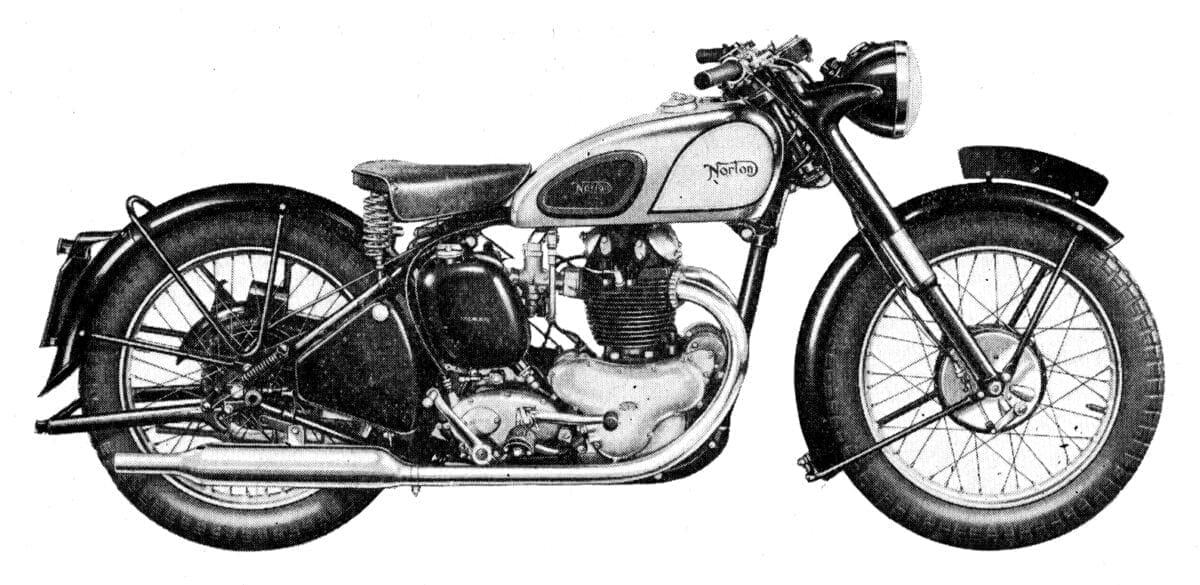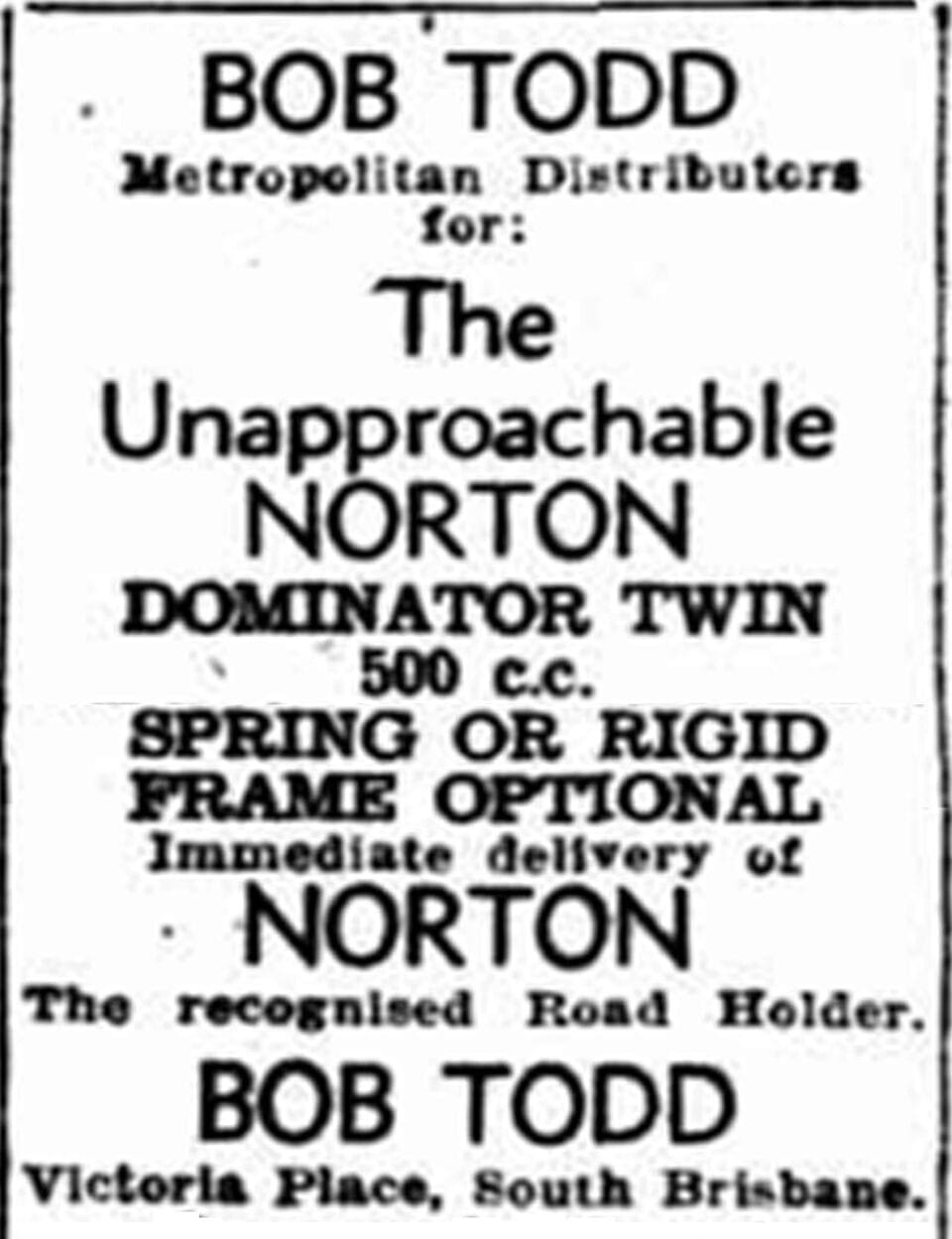In previous episodes, Norton enthusiast Bruce J Tinworth established the existence of a special version of Norton’s twin with a rigid rear end instead of the usual plunger suspension. This export-only ‘Dominator 500 Rigid Sport’ was sent to Australia, where the evidence mounts up that it was far from being a cobble-job of overstocked components…
An iron cylinder head would’ve been standard for the period, but as several of the surviving rigid 77s are equipped with alloy items this has encouraged some folk to argue that all of the bikes are a mix/match amalgam of components, possibly dealer or owner-built specials. Yet in 1949 a Norton poster publicising the release of the Dominator twin documents that a ‘light alloy head and barrel are available at an extra charge’.
It’s entirely possible that some of the Australian twins were so equipped. In 1950, a book is published which details every British motorcycle produced in that year – and it clearly shows a rigid-framed Norton Dominator.

Another book, Modern Motorcycle Maintenance then features a Norton advert with an illustration of the rigid-framed Norton twin. Norton factory race dept records from 1950-52 also document the construction of twin engines with alloy heads in 1950, and all-alloy engines in 1951.
The rigid twin wasn’t displayed at the 1951 Earl’s Court show and wasn’t mentioned in The Motor Cycle’s annual report. But the magazine does mention that as a consequence of the UK Nickel Prohibited Uses Order, ‘machines for the home market will nearly all have enameled tanks, and chromium-plated tanks will, in the main, be reserved for export.’
By 1952 more than 150 rigid-framed Model 77 twins had already been dispatched to Australia. The Norton model catalogue for this market illustrates and documents the specifications of the Model 7 Twin, alongside the Model 77 Twin. Note the 2” lower seat height of the 77…

Shuffle forward a generation or more, and the rigid-framed Norton twin mystery gets mention by respected authors and industry experts. Roy Bacon, in Norton Dominator Twins, provides an illustration of the rigid-framed Dominator. Bacon states that the rigid frame version of the Dominator was thought to have been built, but not offered for sale.
Jim Reynolds in Norton: A Racing Legend states that in 1951 Norton was building several versions of the Dominator, the prototype featherbed, the old fashioned plunger-sprung and the rigid-framed ‘specials’. When contacted in 2013, Reynolds remembered a rigid-framed 500cc twin in racing trim in Les Emery’s Norvil shop, 12 or so years earlier. Les recalled that it was different from other twin cylinder race bikes in that it was in a rigid-frame and that the frame was different to the other Norton rigid frames.

A few Australian newspaper advertisements as seen here, together with the entries from the contemporary books, appear to be the total of printed evidence relevant Norton’s 1950-52 Model 77. But plenty more speculation and hazy recollection exists on the internet.
A post on Access Norton stated that the rigid-framed Norton twin raced at Daytona sometime in the early 1950s.The rigid-framed Norton twins were legal at Daytona because Norton had sent about 200 of them to Australia as production machines. This isn’t hard evidence, but seems plausible.
Other recollections arose during the decades of investigation. In 2016, one David Griffiths from Queensland responded to enquiries about the 1950-52 Model 77. At 91, David was still a member of the local historic motorcycle club and was keen to share his experience with his 1950 rigid-framed Dominator.
He owned a Triumph Speed Twin when the new rigid twin Norton was advertised at Bob Todd’s bike shop. Bob was a local Norton dealer and successful Norton racer, and he convinced David of the superiority of this new rigid-framed Norton twin. The deal was done and the Triumph was sold.

David was a cadet engineer. He completely stripped his new Norton, breathed heavily on the engine and then rebuilt the bike, less all the unnecessary heavy bits. Among his modifications was a forward facing ram-air intake for the carburettor. David took his modified Model 77 club racing at an abandoned airstrip. He said that the needle on the Smith’s speedometer reached 115mph – whatever the real speed, there were none who competed in the club races at Strathpine who could beat his modified Model 77.
In 1951 or 52, one Lionel Berry purchased a rigid-framed Norton twin from Hazell and Moore (H&M) in Newcastle, 100 miles north of Sydney. Lionel is no longer with us, but his brother Darrell remembers the Model 77 Norton. It was a black bike with a chrome tank, silver/grey panels with red and black pinstripes; with a twin cylinder engine and an alloy head in a rigid frame. Darrell spoke highly of his brother’s Norton, saying that it was a very peppy bike, excellent acceleration and handling, with a top speed that few others bikes could beat.

If all this isn’t enough to convince you, look out for Part 4 of the story with further recollections and archive evidence about this unusual Australian export…
———
Words: Bruce J Tinworth / Photos: Bruce J Tinworth, RC RChive
———
Norton weren’t the only British bike builder who created special models and sent them to Australia. In RC205 / May 2021, we tell the story of the Royal Enfield Wallaby – a 250 with a definite spring in its step!




